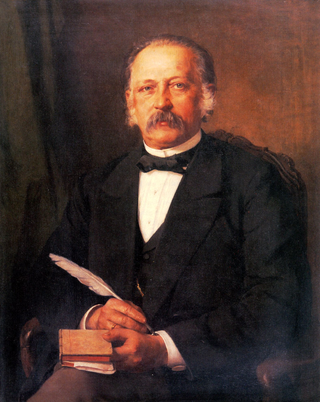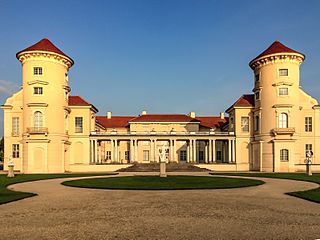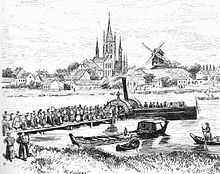
Theodor Fontane was a German novelist and poet, regarded by many as the most important 19th-century German-language realist author. He published the first of his novels, for which he is best known today, only at age 58 after a career as a journalist.

The Protestant Church of the Redeemer is located to the south of the village of Sacrow, which since 1939 has been incorporated to Potsdam, the capital of the German Bundesland of Brandenburg. It is famous for its Italian Romanesque Revival architecture with a separate campanile and for its scenic location. It was built in 1844. The design was based on drawings by King Frederick William IV of Prussia, called the Romantic on the Throne. The building was realized by Ludwig Persius, the king's favorite architect. In 1992, the church along with the park and Sacrow Manor was added by UNESCO to the World Heritage Site "Palaces and Parks of Potsdam and Berlin" for its architecture and cohesion with the surrounding park.

Paretz is a village in the German state of Brandenburg in the district of Havelland, west of Berlin. Recently, a district reform made Paretz into a borough of the city of Ketzin. It has a population of approximately 400. In the late 18th and early 19th centuries, the village was the summer residence of King Frederick William III of Prussia and of his wife Queen Louise.

Werder (Havel) (official name derived from Werder an der Havel ("Werder upon Havel"), colloquially just Werder) is a town in the state of Brandenburg, Germany, located on the Havel river in the Potsdam-Mittelmark district, west of the state's capital Potsdam.

Buckow is a town in the Märkisch-Oderland district, in Brandenburg, Germany. The water cure resort is the administrative seat of the Amt Märkische Schweiz and located in the centre of the eponymous hill range, since 1990 part of the Märkische Schweiz Nature Park protected area.

Teupitz is a small town in the Dahme-Spreewald district, in Brandenburg, Germany. It is the administrative seat of the Schenkenländchen municipal association (Amt).

Schwielowsee is a municipality in the Potsdam-Mittelmark district, in Brandenburg, Germany. It is situated on the shore of the Schwielowsee lake, through which the River Havel flows. The municipality was founded on December 31, 2002 in merger of the three villages Caputh, Geltow and Ferch. The Caputh Ferry, a cable ferry across the Havel, links Caputh and Geltow. In the east Schwielowsee shares border with the City of Potsdam, in the west with the town of Werder (Havel).
Margrave Conrad I of Brandenburg was a member of the House of Ascania and a co-ruler of Brandenburg.

Spreewald gherkins are a specialty pickled cucumber from Brandenburg, which are protected by the EU as a Protected Geographical Indication (PGI).

Maren Kroymann is a German actress, comedian and singer.

Günter de Bruyn was a German author.

Schloss Tamsel is a significant historical estate in the Brandenburg Neumark region. The estate is located in what is today the small village of Dąbroszyn, Poland, and consists of a manor house, a church and a park. It was constructed in the late 17th century by Field Marshal Hans Adam von Schöning. His granddaughter, Luise Eleonore, inherited the castle as a child of four and married Lieutenant-General von Wreech at age 16.

Buch is a German locality (Ortsteil) within the Berlin borough (Bezirk) of Pankow. Situated on the Panke river, it is the city's northernmost quarter, chiefly known for its historic village centre and extended hospital premises.

The Rheinsberg Lake Region with its many great and small lakes, lies in the richly-varied, gently rolling, forested countryside between the villages of Rheinsberg, Menz and Fürstenberg/Havel in the north German state of Brandenburg. It lies just to the south of the Neustrelitz Little Lakes Region, but has no natural link to the waterbodies to the north. However, the Rheinsberg Lake Region is linked to the Neustrelitz lakes via the Wolfsbruch Canal and Lock, the Müritz-Havel Waterway and the Upper Havel Waterway. It drains southwards to the River Havel through the Rhin and is bounded by Ruppin Switzerland to the south. The overwhelming part of the region belongs to the Stechlin-Ruppiner Land Nature Park. The Stechlin Nature Reserve, created in 1938, is well known.

Rheinsberg Palace lies in the municipality of Rheinsberg, about 100 kilometres (62 mi) northwest of Berlin in the German district of Ostprignitz-Ruppin.

Henriette Maria of Brandenburg-Schwedt, was a granddaughter of the "Great Elector" Frederick William of Brandenburg. She was the daughter of Philip William, Margrave of Brandenburg-Schwedt (1669-1711), the eldest son of the elector's second marriage with Sophia Dorothea of Schleswig-Holstein-Sonderburg-Glücksburg. Her mother was Johanna Charlotte (1682-1750), the daughter of Prince John George II, Prince of Anhalt-Dessau.

Wanderungen durch die Mark Brandenburg is a five-volume travelogue by the German writer Theodor Fontane, originally published in 1862–1889. It is his longest work and forms a bridge between his early career as a poet and his later novels. It covers the history, architecture, and people of the region as well as its landscape, and influenced the German Youth Movement of the early twentieth century.

Geographically, the Havelland is the region around which the River Havel flows in a U-shape between Oranienburg to the northeast and Rhinow to the northwest. The northern boundary of the Havelland is formed by the River Rhin and the Rhin Canal. In the history of Brandenburg, the Havelland represents a historic region.

Teltow is both a geological plateau and also a historical region in the German states of Brandenburg and Berlin. As an historical region, the Teltow was one of the eight territories out of which the March of Brandenburg was formed in the 12th and 13th centuries. As a result of the Teltow War (1239–1245) the question of territorial lordship of the newly created heart of the expanding march was finally decided here. Between 1835 and 1952 there was also a county, Teltow district; in addition a town immediately south of Berlin, in the present-day county of Potsdam-Mittelmark, bears the name Teltow.

The St. Nikolai church is the largest medieval church in Jüterbog, Brandenburg, Germany. The nave is a Brick Gothic hall church construction with field stone dual towers that dominate the cityscape. The church was first mentioned in 1307 and likely consecrated in 1488. The Patron saint is St. Nicholas of Myra.





















